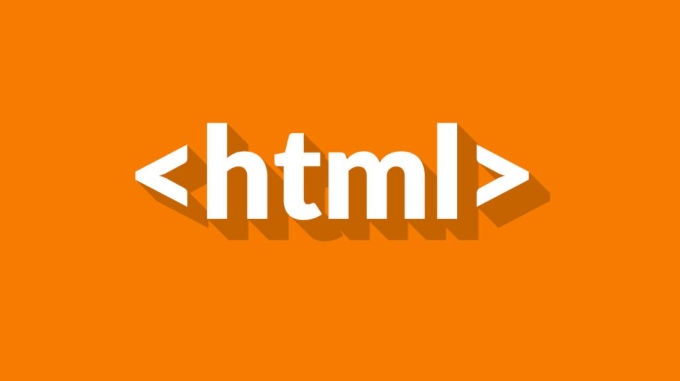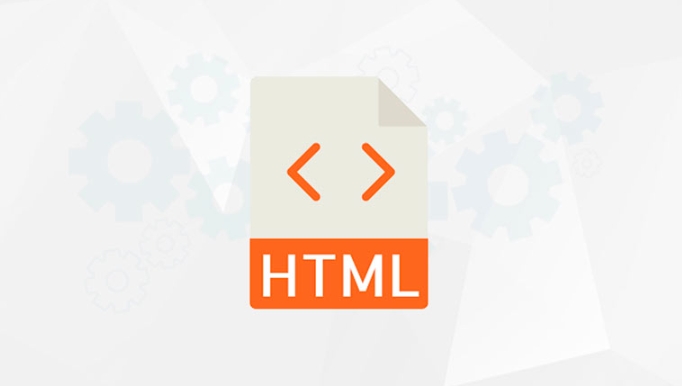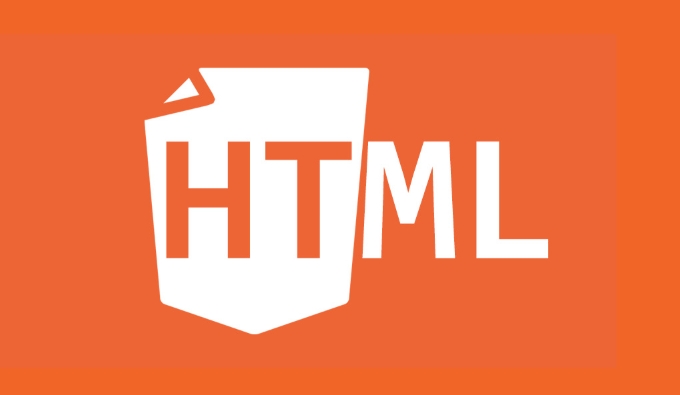Use srcset and sizes to improve image performance and user experience on responsive websites. 1. srcset provides multiple pictures with different sizes or resolutions, such as image-small.jpg 480w or image-2x.jpg 2x; 2. sizes informs the browser of the display width of the pictures under different viewports, such as (max-width: 600px) 100vw; 3. Common errors include ignoring the src attributes, inconsistent units, listing too many sizes, etc. These problems should be avoided to ensure correct loading and layout.

When building responsive websites, handling images properly is cruel for performance and user experience. The srcset and sizes attributes in HTML help browsers choose the best image to load based on screen size and resolution. It might look complicated at first, but once you understand how they work together, it becomes a powerful tool.

What srcset Does
The srcset attribute gives the browser a list of image files and their sizes or resolutions. This lets the browser pick the most appropriate one depending on the device. For example:
<img src="/static/imghw/default1.png" data-src="image-small.jpg" class="lazy"
srcset="image-small.jpg 480w,
image-medium.jpg 800w,
image-large.jpg 1200w"
alt="Responsive image"> Here, each image file is followed by a width descriptor ( 480w , 800w , etc.). The browser uses these to determine which image fits best based on the current viewport.

You can also include resolution describes like 2x for high-DPI screens (like Retina displays):
<img src="/static/imghw/default1.png" data-src="image.jpg" class="lazy"
srcset="image.jpg 1x,
image-2x.jpg 2x"
alt="High-res image"> In short, srcset gives options — but it needs help to decide which one to pick.

How sizes Helps the Browser Choose
The sizes attribute tells the browser how big the image will appear on the page at different viewport sizes. It uses media query-like syntax to define image width in relation to the screen.
Here's an example:
<img src="/static/imghw/default1.png" data-src="image-small.jpg" class="lazy"
srcset="image-small.jpg 480w,
image-medium.jpg 800w,
image-large.jpg 1200w"
sizes="(max-width: 600px) 100vw,
(max-width: 900px) 50vw,
33vw"
alt="Responsive image">Breaking it down:
- On screens narrower than 600px, the image will take up the full width (
100vw). - Between 600px and 900px, it will be half the width (
50vw). - On wider screens, it will be about a third of the width (
33vw).
With this info, the browser can estimate how big the image will be on screen and choose the most suitable image from the srcset .
Common Mistakes and Tips
When using srcset and sizes , it's easy to make mistakes that lead to poor performance or broken images. Here are some common issues and how to avoid them:
- Don't forget the
srcattribute. It acts as a fallback for browsers that don't supportsrcset. - Use consistent units in
sizes. Stick withvw,%, orpx, and make sure they match the layout. - Test different viewport sizes. Use browser dev tools to see which image is loaded at different screen widths.
- Name your images clearly. Something like
image-480w.jpgmakes it easier to manage and understand. - Don't list every possible size. Aim for 3–4 main sizes (small, medium, large) to keep things manageable.
Also, remember that sizes doesn't change the layout — it only tells the browser how much space the image will take. The actual layout should be handled with CSS.
Wrapping It Up
Using srcset and sizes together helps deliver the right image for each device — not too big, not too small. It's not overly complicated once you get the hang of how the browser uses these attributes. Just define your image options in srcset , describe how big it will be on screen with sizes , and make sure your values match your layout.
That's basically it.
The above is the detailed content of HTML `srcset` and `sizes` Explained for Responsive Images. For more information, please follow other related articles on the PHP Chinese website!

Hot AI Tools

Undress AI Tool
Undress images for free

Undresser.AI Undress
AI-powered app for creating realistic nude photos

AI Clothes Remover
Online AI tool for removing clothes from photos.

Clothoff.io
AI clothes remover

Video Face Swap
Swap faces in any video effortlessly with our completely free AI face swap tool!

Hot Article

Hot Tools

Notepad++7.3.1
Easy-to-use and free code editor

SublimeText3 Chinese version
Chinese version, very easy to use

Zend Studio 13.0.1
Powerful PHP integrated development environment

Dreamweaver CS6
Visual web development tools

SublimeText3 Mac version
God-level code editing software (SublimeText3)
 Applying Semantic Structure with article, section, and aside in HTML
Jul 05, 2025 am 02:03 AM
Applying Semantic Structure with article, section, and aside in HTML
Jul 05, 2025 am 02:03 AM
The rational use of semantic tags in HTML can improve page structure clarity, accessibility and SEO effects. 1. Used for independent content blocks, such as blog posts or comments, it must be self-contained; 2. Used for classification related content, usually including titles, and is suitable for different modules of the page; 3. Used for auxiliary information related to the main content but not core, such as sidebar recommendations or author profiles. In actual development, labels should be combined and other, avoid excessive nesting, keep the structure simple, and verify the rationality of the structure through developer tools.
 How to group options within a select dropdown using html?
Jul 04, 2025 am 03:16 AM
How to group options within a select dropdown using html?
Jul 04, 2025 am 03:16 AM
Use tags in HTML to group options in the drop-down menu. The specific method is to wrap a group of elements and define the group name through the label attribute, such as: 1. Contains options such as apples, bananas, oranges, etc.; 2. Contains options such as carrots, broccoli, etc.; 3. Each is an independent group, and the options within the group are automatically indented. Notes include: ① No nesting is supported; ② The entire group can be disabled through the disabled attribute; ③ The style is restricted and needs to be beautified in combination with CSS or third-party libraries; plug-ins such as Select2 can be used to enhance functions.
 Implementing Clickable Buttons Using the HTML button Element
Jul 07, 2025 am 02:31 AM
Implementing Clickable Buttons Using the HTML button Element
Jul 07, 2025 am 02:31 AM
To use HTML button elements to achieve clickable buttons, you must first master its basic usage and common precautions. 1. Create buttons with tags and define behaviors through type attributes (such as button, submit, reset), which is submitted by default; 2. Add interactive functions through JavaScript, which can be written inline or bind event listeners through ID to improve maintenance; 3. Use CSS to customize styles, including background color, border, rounded corners and hover/active status effects to enhance user experience; 4. Pay attention to common problems: make sure that the disabled attribute is not enabled, JS events are correctly bound, layout occlusion, and use the help of developer tools to troubleshoot exceptions. Master this
 Configuring Document Metadata Within the HTML head Element
Jul 09, 2025 am 02:30 AM
Configuring Document Metadata Within the HTML head Element
Jul 09, 2025 am 02:30 AM
Metadata in HTMLhead is crucial for SEO, social sharing, and browser behavior. 1. Set the page title and description, use and keep it concise and unique; 2. Add OpenGraph and Twitter card information to optimize social sharing effects, pay attention to the image size and use debugging tools to test; 3. Define the character set and viewport settings to ensure multi-language support is adapted to the mobile terminal; 4. Optional tags such as author copyright, robots control and canonical prevent duplicate content should also be configured reasonably.
 Best HTML tutorial for beginners in 2025
Jul 08, 2025 am 12:25 AM
Best HTML tutorial for beginners in 2025
Jul 08, 2025 am 12:25 AM
TolearnHTMLin2025,chooseatutorialthatbalanceshands-onpracticewithmodernstandardsandintegratesCSSandJavaScriptbasics.1.Prioritizehands-onlearningwithstep-by-stepprojectslikebuildingapersonalprofileorbloglayout.2.EnsureitcoversmodernHTMLelementssuchas,
 How to associate captions with images or media using the html figure and figcaption elements?
Jul 07, 2025 am 02:30 AM
How to associate captions with images or media using the html figure and figcaption elements?
Jul 07, 2025 am 02:30 AM
Using HTML sums allows for intuitive and semantic clarity to add caption text to images or media. 1. Used to wrap independent media content, such as pictures, videos or code blocks; 2. It is placed as its explanatory text, and can be located above or below the media; 3. They not only improve the clarity of the page structure, but also enhance accessibility and SEO effect; 4. When using it, you should pay attention to avoid abuse, and apply to content that needs to be emphasized and accompanied by description, rather than ordinary decorative pictures; 5. The alt attribute that cannot be ignored, which is different from figcaption; 6. The figcaption is flexible and can be placed at the top or bottom of the figure as needed. Using these two tags correctly helps to build semantic and easy to understand web content.
 HTML for email templates tutorial
Jul 10, 2025 pm 02:01 PM
HTML for email templates tutorial
Jul 10, 2025 pm 02:01 PM
How to make HTML mail templates with good compatibility? First, you need to build a structure with tables to avoid using div flex or grid layout; secondly, all styles must be inlined and cannot rely on external CSS; then the picture should be added with alt description and use a public URL, and the buttons should be simulated with a table or td with background color; finally, you must test and adjust the details on multiple clients.
 How to embed content from another site using the html iframe tag?
Jul 04, 2025 am 03:17 AM
How to embed content from another site using the html iframe tag?
Jul 04, 2025 am 03:17 AM
Use tags to embed other website content into your own web page. The basic syntax is:, you can add width, height, and style="border:none;" to control the appearance; in order to achieve responsive layout, you can set the size through percentage or use containers to combine padding and absolute positioning to maintain the aspect ratio, while paying attention to cross-domain restrictions, loading performance, SEO impact, and security policies. Common uses include embedding maps, third-party forms, social media content and internal system integration.






